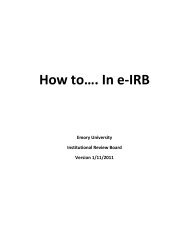A Manual for Participants in Clinical Trials of Investigational Agents ...
A Manual for Participants in Clinical Trials of Investigational Agents ...
A Manual for Participants in Clinical Trials of Investigational Agents ...
Create successful ePaper yourself
Turn your PDF publications into a flip-book with our unique Google optimized e-Paper software.
5.1.3 Comb<strong>in</strong><strong>in</strong>g <strong>Agents</strong><br />
We believe that the most rational approach to development <strong>of</strong> a new cancer agent is<br />
reserv<strong>in</strong>g its comb<strong>in</strong>ation with another agent(s) until it has shown reproducible evidence<br />
<strong>of</strong> activity <strong>in</strong> at least two s<strong>in</strong>gle-agent trials <strong>in</strong> a disease. Alternatively, or <strong>in</strong> addition,<br />
<strong>in</strong>vestigators may propose comb<strong>in</strong>ations when a rationale firmly grounded on laboratory<br />
evidence is relevant to the cl<strong>in</strong>ical circumstance.<br />
In the past, oncologists developed many agent comb<strong>in</strong>ations <strong>in</strong>tuitively; they comb<strong>in</strong>ed<br />
two, three, or more putatively active agents <strong>in</strong> uncontrolled studies <strong>of</strong> antitumor effect<br />
and adverse effects. To be sure, some very real therapeutic advances were achieved by<br />
this process. However, the lack <strong>of</strong> a systematic, stepwise approach and the frequent<br />
absence <strong>of</strong> proper control groups <strong>of</strong>ten left the oncology community <strong>in</strong> the uncerta<strong>in</strong><br />
position <strong>of</strong> not know<strong>in</strong>g whether results with a particular regimen represented progress<br />
or not. A new agent’s overall impact on efficacy and adverse events may rema<strong>in</strong> unclear<br />
without a systematic approach. Ultimately, when available data do not elucidate each<br />
new agent’s specific contribution, the process <strong>of</strong> NDA or BLA approval is impeded.<br />
Intelligently designed and flexible new agent development programs must provide room<br />
<strong>for</strong> both approaches. Well-conceived small pilot trials test<strong>in</strong>g new hypotheses will always<br />
have an important place <strong>in</strong> cancer’s developmental therapy. We shall, however, cont<strong>in</strong>ue<br />
to pay close attention to the rationale beh<strong>in</strong>d all proposed comb<strong>in</strong>ations. We will also<br />
cont<strong>in</strong>ue to ask whether certa<strong>in</strong> proposals <strong>for</strong> therapeutic research might not be better<br />
approached by a phase 3 design rather than phase 2.<br />
In the past, activity was the most common basis <strong>for</strong> a s<strong>in</strong>gle agent’s <strong>in</strong>clusion <strong>in</strong> a<br />
comb<strong>in</strong>ation. CTEP now considers other rationales as well. For example, we consider<br />
radiosensitizers or substantial laboratory evidence <strong>of</strong> synergy between two cancer<br />
agents. This is particularly compell<strong>in</strong>g if it is consistent with a putative mechanism <strong>of</strong><br />
action. Alternatively, an agent <strong>in</strong>ert aga<strong>in</strong>st cancer might be added because <strong>of</strong> evidence<br />
that it alters a second (anticancer) agent’s pharmacodynamics or pharmacok<strong>in</strong>etics.<br />
<strong>Agents</strong> can also be tested as both chemotherapeutics and radiosensitizers. In such<br />
cases, CTEP will carefully assess the rationale and evidence <strong>of</strong>fered <strong>in</strong> support <strong>of</strong> a<br />
proposal.<br />
When <strong>in</strong>vestigators submit comb<strong>in</strong>ation studies to CTEP <strong>for</strong> review, there<strong>for</strong>e, it is<br />
particularly important to state the proposal’s goals, background, and rationale clearly.<br />
• If experimental results <strong>in</strong> the laboratory are the basis <strong>for</strong> the study, they should<br />
be relevant to the cl<strong>in</strong>ical circumstance and cited <strong>in</strong> adequate detail.<br />
• If prelim<strong>in</strong>ary cl<strong>in</strong>ical results are the motivation, they should be similarly cited;<br />
unpublished results should be provided as part <strong>of</strong> the background or <strong>in</strong> an<br />
attachment to the protocol document.<br />
• If the trial proposes a feasibility pilot, the protocol should state clearly what k<strong>in</strong>ds<br />
<strong>of</strong> results the <strong>in</strong>vestigators would regard as medically significant and where they<br />
would propose to go next if a significant result is obta<strong>in</strong>ed.<br />
A detailed plan <strong>of</strong> a follow-up study or detailed speculations about likely outcomes is not<br />
necessary at this stage <strong>of</strong> review. Rather, we are seek<strong>in</strong>g an understand<strong>in</strong>g <strong>of</strong> how the<br />
pilot proposal will fit <strong>in</strong>to a strategy <strong>of</strong> development <strong>of</strong> the new therapeutic idea.<br />
Section 5 - Investigator’s <strong>Manual</strong> 2009 20




